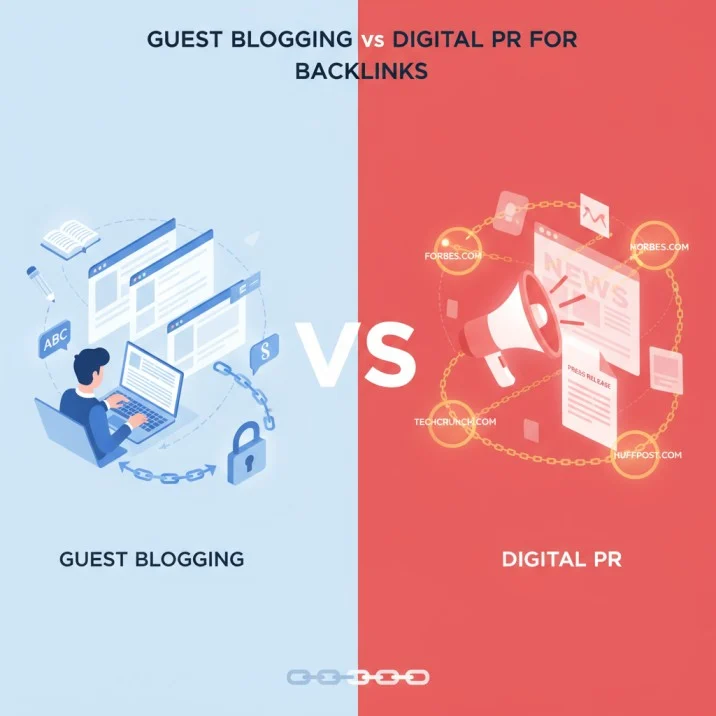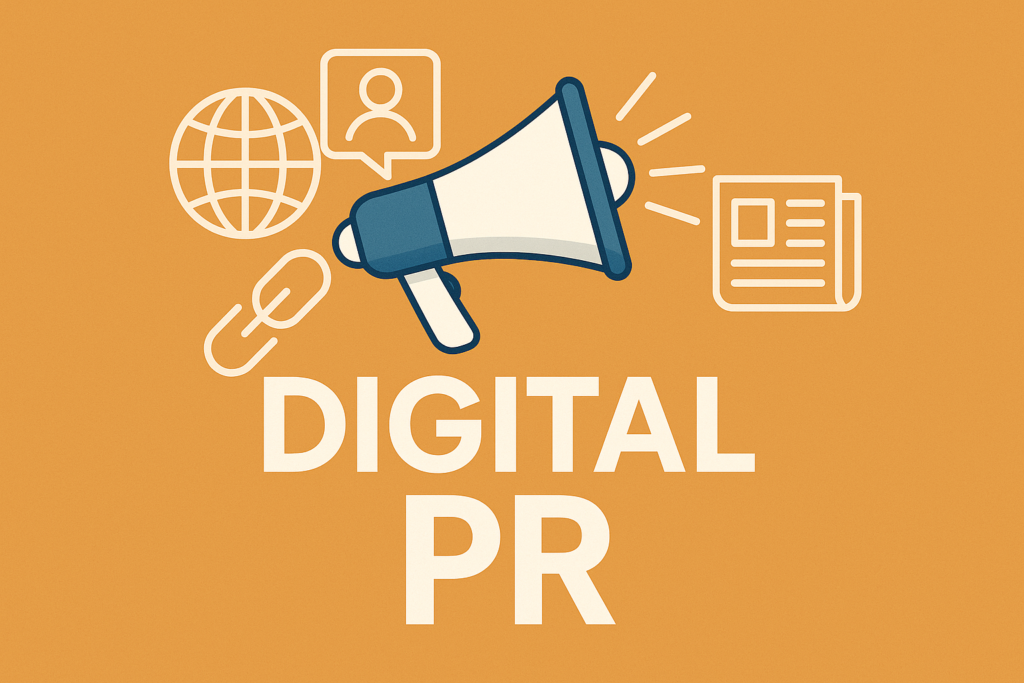Guest Blogging vs Digital PR for Backlinks – What matters the most!
Posted On September 20th, 2025
Array
Why Backlinks Matter in 2025
Before comparing guest blogging and digital PR, let’s understand why backlinks are a big deal. They’re links from other websites pointing to yours, acting like votes of confidence. Search engines use them to gauge your site’s credibility.
- Boost Rankings: High-quality backlinks improve your position on search engine results pages (SERPs). The first organic result gets about 27% of clicks, per Ahrefs data.
- Drive Traffic: Links from relevant sites bring visitors directly to your pages.
- Build Authority: Backlinks from trusted domains signal expertise, especially after Google’s 2023 Helpful Content Update.
- Stay Relevant: In 2025, Google prioritizes links from authoritative, niche-specific sources, making strategies like contributor posting (guest blogging) and virtual press relations (digital PR) critical.
However, low-quality or spammy links can hurt your rankings. That’s why ethical tactics like guest blogging and digital PR shine—they focus on earning links naturally.

What Is Guest Blogging?
Guest blogging, sometimes called contributor authoring, involves writing articles for other websites in your niche. You provide valuable content, and in return, you include a link back to your site, often in the author bio or content body.
- How It Works:
- Find relevant blogs (e.g., “fitness + write for us” for a fitness site).
- Pitch a unique article idea to the site’s editor.
- Write and publish a high-quality post with your backlink.
- Example: If you run a travel blog, you might write “Top 10 Destinations for 2025” for a tourism site, linking to your guide on sustainable travel.
Moreover, guest blogging builds relationships with industry peers, opening doors for future collaborations. I once landed a guest post on a marketing blog, which led to a steady stream of referral traffic for months.
Benefits of Guest Blogging for Backlinks
Guest blogging remains a go-to strategy for link building, with 47% of SEOs using it in 2025. Here’s why it’s effective:
- Targeted Backlinks: You earn links from niche-relevant sites, which Google values highly.
- Increased Exposure: Your content reaches new audiences, driving referral traffic (up to 32% boosts in some cases).
- Establishes Authority: Sharing expertise positions you as a thought leader, potentially leading to speaking gigs or partnerships.
- Cost-Effective: It requires time, not big budgets, unlike paid ads.
- Social Amplification: Engaging posts get shared on platforms like LinkedIn, expanding your reach.
- Data Point: 60% of bloggers write 1-5 guest posts monthly, showing its sustained popularity.
For instance, a single guest post I wrote for a tech blog drove 500 visitors to my site in a week, proving its power when done right.
Drawbacks of Guest Blogging
However, guest blogging isn’t perfect. Here are some challenges:
- Time-Intensive: Researching, pitching, and writing can take hours per post.
- High Rejection Rates: Many pitches get ignored, so persistence is key.
- Quality Risks: Posting on low-authority or irrelevant sites can dilute efforts or attract penalties.
- Delayed Results: Backlinks build authority over time, not instantly.
- Over-Optimization Risks: Stuffing anchor text with keywords can trigger Google’s spam filters.
Despite these hurdles, strategic guest blogging delivers solid results.
Best Practices for Guest Blogging
To make guest blogging work, follow these steps:
- Research Sites: Use tools like Ahrefs to find blogs with Domain Authority (DA) above 50.
- Craft Strong Pitches:
- Personalize: Mention a recent post you liked.
- Propose value: Suggest a topic that solves readers’ problems.
- Write High-Quality Content:
- Match the host’s tone and style.
- Include data, visuals, and examples.
- Add your link naturally, ideally in the bio.
- Promote Your Post: Share it on social media to drive traffic to the host site.
- Track Results: Use Google Analytics to monitor traffic and ranking improvements.
- Build Relationships: Follow up with editors for future opportunities.

What Is Digital PR?
Digital PR, or online publicity, is about earning backlinks and brand mentions through media coverage. You create newsworthy content—like studies or infographics—and pitch it to journalists, influencers, or outlets.
- How It Works:
- Develop a compelling story or asset (e.g., a report on “2025 Consumer Trends”).
- Pitch to media via platforms like HARO or press releases.
- Secure coverage with backlinks from high-authority sites.
- Example: A tech startup might release a study on AI adoption, landing a feature in TechCrunch with a link to their site.
In 2025, digital PR leads link-building tactics, with 89.6% of experts rating it as highly effective. It’s a modern take on traditional PR, tailored for digital impact.
Benefits of Digital PR for Backlinks
Digital PR offers unique advantages for link building:
- High-Authority Links: Coverage from sites like Forbes or CNN boosts your domain rating significantly.
- Enhanced Reputation: Positive media mentions build trust, encouraging organic links.
- Scalable Impact: One campaign can yield multiple placements across outlets.
- Direct Traffic: Features with calls to action drive visitors to your site.
- Ethical Approach: Earned links align with Google’s guidelines, reducing penalty risks.
- Data Point: Digital PR campaigns often improve SEO and traffic measurably.
For example, a viral campaign by a skincare brand I worked with landed features in 10 outlets, doubling their organic traffic in two months.
Drawbacks of Digital PR
However, digital PR has its challenges:
- High Costs: Creating assets or hiring agencies can cost thousands, with no guaranteed results.
- Low Response Rates: Only 3.43% of PR pitches get replies in 2025.
- Competitive Landscape: Standing out is tough, with 72% of pros finding PR harder this year.
- Limited Control: Media may alter your story or exclude links, reducing SEO value.
- Complex ROI Tracking: Measuring direct impact on traffic versus brand sentiment is tricky.
Despite these, the potential for high-impact links makes digital PR a favorite for big brands.
Best Practices for Digital PR
To nail digital PR, try these tips:
- Research Journalists: Use tools like Muck Rack to find niche-specific reporters.
- Create Newsworthy Assets:
- Conduct original research (e.g., a survey).
- Design infographics or expert roundups.
- Craft Personalized Pitches:
- Reference their recent work.
- Explain why your story fits their audience.
- Time Pitches Strategically: Tie to trending topics for better pickup.
- Follow Up Politely: A gentle nudge can boost response rates.
- Monitor Coverage: Use Google Alerts or Meltwater to track mentions and links.
Moreover, build long-term media relationships to secure recurring opportunities.
Guest Blogging vs Digital PR: A Head-to-Head Comparison
Now, let’s break down the key differences in a clear, point-by-point format:
- Control:
- Guest Blogging: High—you write and submit the content.
- Digital PR: Medium—you rely on journalists to publish.
- Link Quality:
- Guest Blogging: Varies, often niche-specific (DA 30-60).
- Digital PR: High, from top-tier sites (DA 70+).
- Time Investment:
- Guest Blogging: Moderate, per post (5-10 hours).
- Digital PR: High, per campaign (weeks or months).
- Cost:
- Guest Blogging: Low to medium (mostly time-based).
- Digital PR: Medium to high (assets, agencies).
- Scalability:
- Guest Blogging: Limited by writing capacity.
- Digital PR: High—one asset can yield multiple links.
- Risk:
- Guest Blogging: Potential penalties if you use spammy sites.
- Digital PR: Low, as links are earned organically.
- Brand Impact:
- Guest Blogging: Builds personal or niche authority.
- Digital PR: Enhances overall brand reputation.
As you can see, guest blogging offers more control and affordability, while digital PR delivers bigger wins in authority and reach. Both complement a strong SEO strategy.
How to Choose Between Guest Blogging and Digital PR
Choosing the right tactic depends on your goals and resources. Here’s a quick guide:
- Pick Guest Blogging If:
- You need quick, targeted links.
- You’re a solopreneur or small team with limited budget.
- Your niche allows for niche-specific outreach.
- Pick Digital PR If:
- You want high-authority links from major outlets.
- You have the budget for campaigns or agencies.
- You’re in a competitive industry needing broad visibility.
- Try Both If:
- You have resources to balance quick wins and long-term gains.
- You want to maximize backlinks and brand exposure.
Additionally, test small campaigns to see what resonates with your audience. For example, start with one guest post and one PR pitch to gauge results.
Integrating Guest Blogging and Digital PR for Maximum Impact
Why choose when you can combine them? Here’s how they work together:
- Leverage PR for Guest Blogging:
- Mention a media feature in your guest post pitch (e.g., “As seen in Forbes”) to boost credibility.
- Use PR wins to secure invites from high-DA blogs.
- Repurpose PR Assets:
- Turn a research study into guest posts for multiple sites.
- Create blog content summarizing your PR campaign’s findings.
- Amplify Reach:
- Promote guest posts via PR channels to drive traffic.
- Share PR coverage on social media to encourage natural links.
For instance, a client of mine used a digital PR campaign to land a feature in a major outlet, then referenced it in guest posts, boosting their acceptance rate by 20%.
Common Mistakes to Avoid
Both strategies have pitfalls. Steer clear with these tips:
- Don’t Chase Quantity:
- Focus on quality links from reputable sites to avoid penalties.
- Avoid Generic Pitches:
- Personalize outreach to improve response rates.
- Don’t Skip Follow-Ups:
- Polite nudges can turn rejections into acceptances.
- Match the Audience:
- Ensure content aligns with the host site’s readers.
- Track Everything:
- Use tools like Google Analytics to measure traffic, rankings, and ROI.
Moreover, prioritize E-E-A-T (Experience, Expertise, Authoritativeness, Trustworthiness) to align with Google’s guidelines.
Real-World Case Studies
Let’s look at some success stories to inspire you:
- Guest Blogging Example:
- Respona, an outreach tool, secured 55 guest posts in a month by targeting high-DA sites with personalized pitches. Result? A 40% traffic increase.
- Another Guest Blogging Win:
- A lifestyle blogger used contributor posting to grow organic traffic 5x in three months by focusing on niche-relevant, high-quality sites.
- Digital PR Example:
- Reboot Online’s campaign for a client earned 20+ high-authority links, boosting organic clicks by 36% through strategic media outreach.
- Digital PR Long-Term Success:
- Digitaloft’s sustained PR efforts in a competitive niche led to consistent ranking improvements over a year, proving PR’s staying power.
These cases highlight how both guest blogging and digital PR deliver when executed thoughtfully.
Future Trends in Guest Blogging and Digital PR for 2025
Looking ahead, here’s what’s shaping these strategies:
- AI Integration: AI tools may streamline pitch creation, but human creativity remains key for standout content.
- Voice and Visual Search: Optimize for conversational queries and images in guest posts and PR assets.
- Sustainability Focus: Brands tackling eco-friendly topics could gain PR traction.
- E-E-A-T Emphasis: Google’s focus on expertise means both tactics must showcase authority and trust.
- Video Content Rise: Incorporate video summaries in guest posts or PR campaigns for broader appeal.
Additionally, stay agile. Algorithms evolve, so keep testing and adapting.
Conclusion
To wrap up, guest blogging and digital PR are both stellar for building backlinks, each with unique strengths. Guest blogging (or contributor authoring) offers control and niche targeting, while digital PR (virtual press relations) delivers high-authority links and brand boosts. By understanding their differences and combining them strategically, you can supercharge your SEO. Start small, track results, and scale what works. Have you tried either tactic yet? Share your experiences in the comments—I’d love to hear!
Top Digital Marketing Channels You Must Know – SEO, SMM, PPC, Email, Content ! Click here to see.
Related Posts

Good SEO vs Bad SEO on Google: The Real Difference That Shapes Your Ranking
Posted on November 4th, 2025
When we talk about SEO on Google, there’s always a battle going on — good SEO vs bad SEO. Everyone wants to rank higher, but not everyone knows the...
Read More →
Google Algorithm Update and SEO Changes: Everything You Must Know
Posted on October 28th, 2025
The world of Google algorithm updates and SEO is constantly evolving, bringing new challenges and opportunities for digital marketers, website owners, and content creators. Every few months, Google rolls...
Read More →
Top Keyword Research Tools(Free & Paid): The Ultimate Guide for SEO Success
Posted on October 22nd, 2025
In 2025, when Keyword Research Tools, SEO, and Search Engine Optimization have become the foundation of every successful online strategy, choosing the right tools can completely change your digital...
Read More →
How Search Engine Algorithm Work: Complete Guide
Posted on September 30th, 2025
Introduction to How Search Engine Algorithm Work When people search online, they depend on the engine to provide helpful and relevant results. The algorithm does the work of analyzing...
Read More →© All Copyright Reserved japjitravel.com
Leave a Comment :